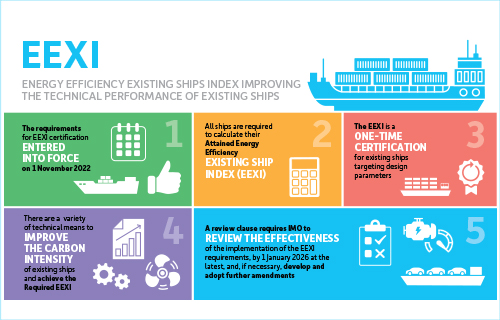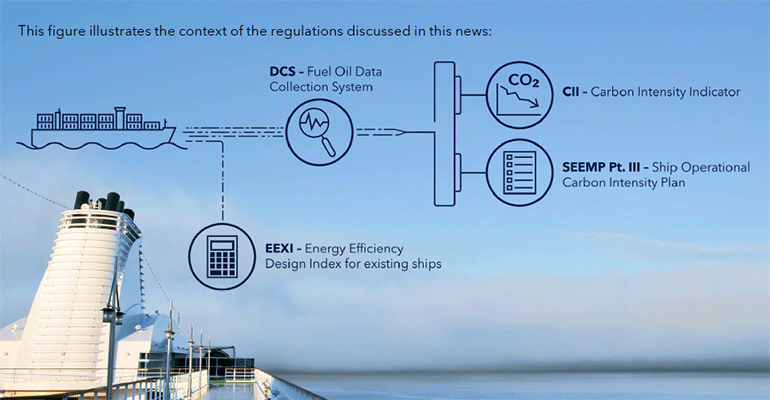The shipping industry plays a crucial role in global trade and transportation, but it also contributes significantly to greenhouse gas emissions. In an effort to reduce the carbon intensity of the international shipping industry, the International Maritime Organization (IMO) has set ambitious goals and implemented new regulations. Two key measures, the Energy Efficiency Existing Ship Index (EEXI) and the Carbon Intensity Indicator (CII), have come into effect from January 1, 2023. These regulations aim to assess, measure, and reduce the CO2 emissions intensity of existing ships. In this article, we will provide a comprehensive overview of EEXI and CII, their calculation methods, the impact they will have on the industry, and how stakeholders can comply with the new regulations.
EEXI: Energy Efficiency Existing Ship Index
The Energy Efficiency Existing Ship Index (EEXI) is a technical efficiency measure that applies to every existing international cargo and passenger vessel with a gross tonnage (GT) of 400 and above. The goal of EEXI is to ensure that these ships reach a target energy efficiency value by the first renewal of their International Air Pollution Prevention (IAPP) survey. This measure assesses a ship’s CO2 emissions related to its transport capacity.
Calculating EEXI

The calculation of EEXI is based on the formula for Energy Efficiency Design Index (EEDI), which measures a ship’s energy efficiency per mile of ship capacity transport work. It takes into account various factors such as the installed power of the vessel’s engines, specific fuel consumption, conversion factors for fuel and CO2 emissions, the ship’s capacity (usually deadweight), and the reference level of installed power. Correction factors can also be applied to account for vessel types or structural enhancements.
Improving EEXI Ratings
To improve their EEXI ratings, ship owners can consider installing Engine Power Limitation (EPL) systems that limit the ship’s maximum power, speed, fuel consumption, and CO2 emissions. In some cases, additional Energy Saving Technologies (ESTs) may be necessary to achieve significant reductions in EEXI.
Compliance and Responsibility
All ships are required to have an IAPP certificate, which now includes the EEXI value as a new requirement from January 2023. If a vessel does not meet the EEXI requirements, the ship owner must take action to improve its rating. It is the responsibility of the vessel owner to calculate and submit the EEXI rating.
CII: Carbon Intensity Indicator
The Carbon Intensity Indicator (CII) is an operational efficiency measure applicable to vessels over 5,000 GT, starting from 2023. It calculates the annual average CO2 emissions per mile of ship capacity transport work. Vessels are given a rating between A and E based on their CII performance, with a ‘C’ rating or better considered compliant.
Calculating CII
CII is calculated by dividing the total annual CO2 emissions by the vessel’s capacity (deadweight or GT) and multiplying it by the total distance traveled in a year. Correction factors may be applied for specific vessel types or voyages. The CII rating is based on the previous year’s emissions.
Improving CII Ratings
Reducing sailing speed is widely recognized as an effective way to comply with CII regulations. Retrofitting Energy Saving Technologies (ESTs) can also help improve a vessel’s CII rating. Additionally, operational efficiencies such as optimizing sailing routes, reducing waiting times, and ensuring vessels remain in good condition can contribute to better CII performance.
Compliance and Responsibility
To be compliant with CII regulations, vessels must achieve a ‘C’ rating or above. Ships rated as ‘D’ or ‘E’ will need to implement a corrective action plan to improve their rating. The vessel owner is responsible for calculating and submitting the CII rating. CII will become a key performance indicator in the market, potentially impacting chartering decisions, values, financing, and insurance.
The Impact of EEXI and CII on Decarbonization

The implementation of EEXI and CII is expected to drive significant improvements in the energy efficiency and carbon intensity of the shipping industry. Market feedback and analysis suggest that most ships will be able to achieve EEXI compliance with minor modifications such as speed reductions or the fitting of Energy Saving Technologies (ESTs). However, a small proportion of the fleet may require major modifications or may be non-compliant initially. Similarly, CII regulations will push for continuous improvement in carbon intensity, with thresholds becoming more stringent each year. The overall impact on decarbonization will depend on the industry’s ability to adopt energy-efficient practices and technologies.
How Clarksons Can Assist with EEXI and CII Compliance
Complying with EEXI and CII regulations requires careful evaluation and decision-making. Clarksons, a leading provider of maritime services, can assist stakeholders in understanding their exposure to EEXI and CII regulations and evaluating improvement options. With their expertise and insights, stakeholders can make informed business decisions to ensure compliance with the new regulations and optimize their operations.
Conclusion
The implementation of EEXI and CII regulations marks a significant step towards reducing the carbon intensity of the shipping industry. These measures aim to improve the energy efficiency of existing ships and drive continuous improvement in carbon intensity. Ship owners and stakeholders must understand the requirements, calculate and submit the necessary ratings, and take appropriate actions to ensure compliance. With the help of industry experts like Clarksons, stakeholders can navigate the complexities of EEXI and CII and contribute to a more sustainable future for the shipping industry.
